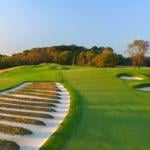After the incident in Japan, similar episodes of manic depression followed much more regularly in Bert Yancey’s life. The one most well known occurred in New York City. It was at the 1975 Westchester Classic. Yancey was paired with his best friend on the Tour and an outstanding player—Tom Weiskopf. Tom was very sensitive to Bert’s psychological condition. But Weiskopf was known for having a short fuse himself. Yancey said some things on the course that upset Weiskopf immeasurably, things that Tom never revealed to the media or us pros.
As soon as Bert completed his round, and upon missing the 36-hole cut, he went to the New York LaGuardia airport to board an airplane to go home. But when he arrived at the airport, he climbed up a ladder and clambered onto a roof. Using it as a bully pulpit, Yancey started preaching loudly again, this time to the traveling masses below him. He reportedly first ordered all blacks and whites to separate, and then he expounded to them upon the evils of racial prejudice.
On another occasion, Bert got into trouble because he thought he was divinely sent on a mission to discover a cure for cancer. One time, Bert told me very seriously that he would rather have been a medical doctor than a professional golfer so that he could have contributed something more worthwhile to humanity. So, it seems Bert had that save-the-world mentality.
Links Letter (Vol. 4, No. 3, 3), in its interview with Bert Yancey, relates his own account of his struggling recovery from his illness, which the medical community later labeled as “bipolar:”
…………….
The turnabout in his [Yancey’s] treatment came in his ensuing hospitalization at New York’s Payne-Whitney Institute, where he was first diagnosed as manic-depressive. He was given lithium, a medication that stabilizes the mood swings that often remain dormant for long periods of time, in Yancey’s case, thirteen years. Although medical treatment has helped him immensely, Yancey credits his recovery to a Special Relationship.
“My illness requires controls, both medical and psychological,” he said. “The stabilizing force that assures me things are okay is my relationship with God through Christ. It allows me to communicate. And whether I feel manic [high] or depressed [low], it helps me make it through and not get out of control. I doubt that I could make it through normal, healthy life without faith. Faith is the strongest control in my life.”
More than medical problems caused Yancey to search deeper for answers to his difficulties. His wife had left him, taking their children, and in turn they were divorced, leaving him in an empty house with nothing to do. Hand tremors, one of lithium’s side effects, prevented him from playing competitive golf. His life was in shambles. But he found a ray of hope, literally, in the darkness.
“I was sitting in the house and I saw a sword in the corner,” he said. “It was my grandfather’s from the Civil War. As I looked at it and the way the light shone on it, the sword appeared to be a cross. All of a sudden I was struck with the idea that there—the cross—was the last thing I had to go on. And I knew I would make it through.”
……
“When things have been bad, I’ve always felt that they will ultimately work for good,” he said. “Faith is like a rope, made up of strands. Sometimes those strands fray when you don’t feel assured. It’s the last strand, that sword in the corner, the one you have to hold on to, that the others are ravelled together around. That center strand, to me, is a cable that will never break, because when faith is tested, that’s when it’s strengthened. It’s a challenge when things go bad, but you just have to hold on.”
…………….
Despite the peace of mind that often eluded Bert Yancey, he certainly had made peace with his Maker.
Years later, Bert disclosed to me that whenever he got on one of those high mood swings—which was his particular problem and not the lows—it was because he indulged himself in excessive imagination. He said he often would imagine being on a divine mission to save the world from something. He said the more he concentrated on that, the more “high” he got. It felt so good to him physically that he didn’t want to quit. “It was like being on a stimulant drug,” he told me.
Yancey’s treatment for manic depression (bipolar) ended his Tour career in 1976. Bert had been one of the best putters on Tour. For instance, he won the 1966 Portland Open with 102 putts, a record that lasted the next eleven years. But lithium caused him to have hand tremors, making his hands shake slightly, and that’s what ended his career. Ask any golfer: there’s nothing worse that can happen to your golf game than to get “the shakes,” also called “the yips,” with the putter, unless it’s “the shanks” with the irons.
After leaving the Tour, Yancey became a nationally recognized golf instructor at Hilton Head Island, South Carolina. He also became a polished traveling speaker for the Mental Health Association. Bert was never ashamed to admit his illness and openly discuss it. Some people are frightened of those who suffer with bipolar. One of Bert’s passions was to help relieve such fears by educating the masses about it. That was the closest Bert ever came to fulfilling his dream of being a medical doctor.
When Yancey was about to turn fifty, he was wishing that he could revive his pro golf career by joining the Senior Tour. Presto! He got rid of the shakes with the putter by getting a new medicine that replaced lithium. After he played in his first tournament in twelve years, the media reported he said, “I’ve been in padded cells and straightjackets, and, believe me, this is better.”
So, Bert Yancey got out on the Senior Tour and played for a few years. His hand tremors were gone and his smooth, putting stroke was coming back. A lot of people were rooting for Bert to regain his old form and move into the winner’s circle again. He had even gotten married for the second time, but, unfortunately, that didn’t last long.
Then tragedy struck. Bert Yancey was standing on the practice tee at Park City, Utah, warming up to tee off in the first round of the Senior Tour’s 1994 Franklin Quest Championship. He suffered a violent heart attack and died minutes later at the age of 56. The PGA Tour lost another one of its members rather early from its ranks. There is a memorial plaque in honor of Bert Yancey there on the practice tee at Park Meadows Golf Club, right where he collapsed.
Bert’s close friend, Tom Weiskopf, recently had turned fifty years of age and had rejoined the pro ranks on the Senior Tour. He was playing there at Park City as well. When Bert died, Tom then became determined to win the tournament for his pal. And that he did in glorious fashion. He birdied the last three holes and beat Dave Stockton in a playoff. It was the only tournament Weiskopf won on the Senior Tour. He was focused for Bert. Tom then had tournament officials engrave the trophy with both his and Bert’s names.
Bert Yancey was survived by three sons, a daughter, four grandchildren, five sisters, and a twin brother. The inscription on that granite slab on the practice range at Park Meadows Golf Club in Park City, Utah, reads as follows:
“Bert Yancey was a tenacious champion with unusual courage, determination, wit and wisdom. As a true professional, he exemplified persistence through hardship. He had a undying passion for preserving the history and integrity of golf. His quest for excellence remained intense and focused as he executed his final shot from this area.”
[These Monday posts represent chapters in a book I am writing entitled Christ on the PGA Tour.]












